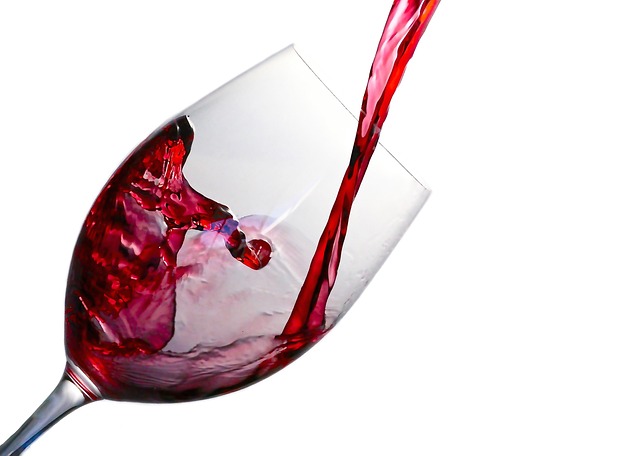Are you a wine enthusiast wondering about the roots of that delightful Sangiovese that graces your glass? Well, you’ve come to the right place! In this enlightening article, we will embark on a fascinating journey to trace the origins of Sangiovese wine, exploring the regions, tales, and terroirs that contribute to its undeniable allure. So, sit back, relax, and prepare to immerse yourself in the rich history and heritage of this renowned varietal – from its humble beginnings to its thriving presence in the wine world today. Prepare to be captivated as we unveil the story behind where Sangiovese wine truly comes from.
Obsah
- The Origins of Sangiovese: Unraveling the Rich History and Heritage of this Iconic Wine
- Exploring the Sangiovese Grape: Understanding its Characteristics and Flavor Profile
- A Journey through Tuscany: Discovering Sangiovese’s Heartland
- Beyond Tuscany: Regions that Showcase the Versatility of Sangiovese
- Sangiovese Wine Production: From Vineyard to Bottle
- Expert Recommendations: Noteworthy Sangiovese Wines to Try
- Unveiling the Secrets: Pairing Sangiovese with Food for Optimal Enjoyment
- The Conclusion
The Origins of Sangiovese: Unraveling the Rich History and Heritage of this Iconic Wine
Sangiovese is one of Italy’s most celebrated and beloved grape varietals, an iconic wine that encapsulates the rich history and heritage of the Italian winemaking tradition. Its origins can be traced back to ancient times, as far as the Roman era, when this unique grape was cherished for its ability to produce complex and flavorful wines.
Believed to have originated in the picturesque region of Tuscany, Sangiovese boasts a wide range of sub-varieties, each with its own unique characteristics and nuances. Some of the most famous Tuscan sub-varieties include Chianti, Brunello di Montalcino, and Vino Nobile di Montepulciano, all of which have their distinct flavor profiles and aging requirements. The grape’s adaptability to different microclimates within Tuscany has allowed winemakers to produce a diverse array of Sangiovese wines, each showcasing the terroir and winemaking traditions of their respective regions.
Key attributes of Sangiovese:
- Brilliant red color with medium to high acidity and moderate tannins
- Aromas ranging from red fruits like cherry and raspberry to floral notes and earthy undertones
- Distinctive combination of flavors, including red berries, dried herbs, leather, and spice
- Can be enjoyed young, offering vibrant fruit flavors, or aged to develop complex and velvety characteristics
Today, Sangiovese continues to be highly revered by wine enthusiasts worldwide, and its popularity has extended beyond the borders of Italy. Winemakers around the globe have recognized the allure of this exceptional varietal, resulting in Sangiovese plantings in diverse wine regions, from California to Australia and Argentina. Whether you are a devotee of this iconic Italian wine or new to the world of wine exploration, delving into the origins and many expressions of Sangiovese is a fascinating journey that uncovers centuries of tradition and artistry.
Exploring the Sangiovese Grape: Understanding its Characteristics and Flavor Profile
Sangiovese, the iconic grape of Italy, is known for its vibrant flavors and distinct characteristics that capture the essence of the country’s winemaking traditions. This versatile grape variety is primarily grown in the heart of Tuscany, where it thrives under the Mediterranean climate and limestone-rich soils. Let’s delve into the captivating world of Sangiovese and uncover its unique qualities.
1. Appearance: Sangiovese grapes typically have a medium-sized, elliptical shape with a deep blue-black color when fully ripe. Their thick skin provides excellent protection against sunburn and allows for extended ripening periods, resulting in well-developed flavors.
2. Aromas: When it comes to aromatics, Sangiovese delights with a bouquet that combines fresh red fruits like cherries and strawberries with earthy undertones and hints of spice. This uniquely captivating blend gives the grape its trademark aroma.
3. Flavor Profile: One sip of Sangiovese and you’ll understand its renowned reputation. The flavors are rich and complex, showcasing a harmonious balance between ripe red fruits, elegant acidity, and a subtle bitterness. Depending on the aging process, the wine can exhibit notes of leather, tobacco, or even balsamic. Sangiovese offers a medium to full-bodied palate with velvety tannins that add depth and structure to the wine.
4. Food Pairing: Thanks to its versatility, Sangiovese allows for a wide range of food pairings. It beautifully complements classic Italian dishes such as pasta with meat-based sauces, roasted meats like lamb or beef, and aged cheeses. The acidity of Sangiovese cuts through the richness of these dishes, creating a harmonious and memorable dining experience.
Exploring the Sangiovese grape is like embarking on a sensory journey through the scenic vineyards of Tuscany. Its vibrant characteristics and captivating flavor profile make it a beloved choice for both casual wine enthusiasts and seasoned sommeliers. Discover the magic of Sangiovese and savor the taste of Italy’s winemaking heritage with every sip.
A Journey through Tuscany: Discovering Sangiovese’s Heartland
Tuscany, located in central Italy, is renowned for its breathtaking landscapes, world-class art, and exquisite cuisine. However, there is another hidden gem waiting to be discovered in this enchanting region – the heartland of Sangiovese, one of Italy’s most iconic grape varieties. Embark on a captivating journey through the undulating vineyards and picturesque villages of Tuscany, and unlock the secrets of Sangiovese’s ancestral home.
As you traverse through this remarkable region, you will encounter a plethora of vineyards dedicated to cultivating Sangiovese grapes. This noble variety thrives under the Tuscan sun, benefiting from the diverse microclimates, fertile soils, and cooling Mediterranean breezes. The resulting wines are a true reflection of Tuscany’s terroir, displaying remarkable depth, complexity, and elegance. Be prepared to immerse yourself in a symphony of flavors, as Sangiovese captivates your palate with its vibrant red fruit, earthy undertones, and a characteristic touch of cherry. Its versatile nature allows winemakers to craft a diverse range of styles, from the robust and structured Chianti Classico to the refined and ethereal Brunello di Montalcino.
Beyond Tuscany: Regions that Showcase the Versatility of Sangiovese
Sangiovese, a beloved Italian grape varietal known for its role in producing some of Tuscany’s finest wines, can also be found beyond the picturesque hills of this renowned region. With its adaptability to different climates and soil types, Sangiovese has proven itself as a versatile grape that can thrive in various terroirs across Italy. Whether you’re a wine enthusiast or a curious explorer of different flavors, here are some regions beyond Tuscany where Sangiovese showcases its versatility:
The Umbrian Utopia:
Nestled right beside Tuscany, Umbria stands as an idyllic landscape, home to exceptional Sangiovese wines. Here, the grape showcases a different character, often lending itself to wines with energetic acidity and vibrant red fruit flavors. The region’s cooler climate and higher elevation contribute to Sangiovese’s elegant and fresh expression, delivering wines with excellent aging potential. Be sure to explore Umbria’s renowned appellations such as Montefalco and Torgiano, which produce Sangiovese-based wines noted for their remarkable balance and silky tannins.
Romantic Romagna:
On the eastern side of Italy, in the region of Emilia-Romagna, lies the charming and romantic land of Romagna. Here, Sangiovese finds a sense of place like no other. With its unique microclimate, influenced by the nearby Adriatic Sea, Sangiovese grapes in Romagna develop a distinctive character. The resulting wines often showcase richness, depth, and complex aromas of ripe cherries, violets, and spices. Explore the superior wines of Romagna’s sub-regions such as Romagna Sangiovese Superiore and Romagna Albana, both offering exceptional expressions of Sangiovese that should not be missed.
Sangiovese Wine Production: From Vineyard to Bottle
Producing exquisite Sangiovese wine is an art that requires careful attention to every step of the process, starting from the nurturing of the vineyard to the final bottling. Let’s take a journey through the fascinating journey of Sangiovese wine production.
Vineyard Management:
It all begins in the vineyard, where the Sangiovese grapes thrive under the watchful eye of experienced viticulturists. From selecting the perfect site, considering factors such as soil composition and sun exposure, to planting and maintaining the vineyard, every decision plays a crucial role in defining the quality of the wine.
- Grape Harvesting: The moment of truth arrives as the grapes ripen to their optimum level of sugar and acidity. Skilled hands selectively pick the clusters in small batches, ensuring only the finest grapes are chosen for the production process.
- Gentle Crushing and Fermentation: Once harvested, the grapes are gently crushed to extract their juice, which is then fermented. This initial fermentation process transforms the natural sugars in the grapes into alcohol, under the meticulous watch of the winemakers. Temperature control and timing are critical factors for maximizing flavor and maintaining balance throughout the fermentation process.
- Aging and Oak Maturation: After primary fermentation, the young wine undergoes a process of aging. Traditionally, Sangiovese wine is aged in oak barrels, allowing it to develop greater complexity and depth. The wine gracefully matures over time, absorbing the nuances of the wood and intensifying its flavors.
- Bottling and Cellaring: Once the desired aging period is complete, the wine is meticulously bottled and sealed. The bottles are then stored in temperature-controlled cellars, allowing them to further evolve and reach their full potential, both in terms of flavor development and texture.
By seamlessly combining the art of viticulture with meticulous winemaking techniques, the journey of Sangiovese wine from vineyard to bottle results in a beautifully crafted libation that captivates the senses. Each sip tells the story of the land, the vines, and the hands that lovingly guided it through every step of its transformation.
Expert Recommendations: Noteworthy Sangiovese Wines to Try
When it comes to Sangiovese wines, there is a wealth of exceptional options to explore. Whether you’re a seasoned wine enthusiast or a curious beginner, these expert recommendations are sure to pique your interest. Known for its vibrant acidity, cherry flavors, and earthy undertones, Sangiovese is a versatile grape that thrives in various regions around the world. Here are a few standout selections that promise to deliver an unforgettable tasting experience:
- Brunello di Montalcino: Hailing from Tuscany, Italy, Brunello di Montalcino is often regarded as one of the finest expressions of Sangiovese. Aged for a minimum of five years (with at least two years in oak), this wine boasts complex aromas of red fruits, tobacco, and spices. With its firm tannins and remarkable aging potential, Brunello di Montalcino is a true connoisseur’s delight.
- Vino Nobile di Montepulciano: Another Tuscan gem, Vino Nobile di Montepulciano impresses with its elegance and refined character. Made predominantly from Sangiovese, this wine is aged for at least two years (one year in oak) before release. It showcases notes of black cherry, violets, and dried herbs, with a velvety texture and a lingering finish. If you’re seeking a balanced and approachable Sangiovese, look no further.
- Chianti Classico: A true classic, Chianti Classico reigns from the heart of Tuscany and embodies the essence of Sangiovese. With bright red fruit flavors, floral hints, and a touch of earthiness, this dry and food-friendly wine is a fantastic everyday choice. Chianti Classico must be aged for a minimum of one year before release, ensuring the development of charming complexities that make it a beloved choice among wine enthusiasts.
These noteworthy Sangiovese wines represent just a small selection of the countless options available. Whether enjoyed on their own or paired with a delectable meal, each bottle holds its own distinct character and heritage. Embark on a delightful journey through the world of Sangiovese and savor the unique flavors this magnificent grape has to offer.
Unveiling the Secrets: Pairing Sangiovese with Food for Optimal Enjoyment
When it comes to unlocking the full potential of Sangiovese, a little culinary finesse can go a long way. This versatile red wine, with its vibrant acidity and nuanced flavors, is a delight to pair with a variety of dishes. Whether you’re savoring a rich pasta dish or indulging in a succulent steak, Sangiovese has the ability to elevate your dining experience to new heights.
Wondering how to make the most out of this intriguing Italian varietal? Here are a few insider tips to help you achieve the ultimate food and wine synergy:
- Embrace the classics: Sangiovese is a quintessential companion for traditional Italian cuisine. Try pairing it with classic dishes like tomato-based pasta sauces, rustic pizzas, or savory risottos.
- Experiment with cheese: Sangiovese’s medium body and earthy flavors make it a natural partner for a variety of cheeses. From aged Parmigiano-Reggiano to tangy Pecorino, explore different cheese pairings to discover delightful flavor harmonies.
- Discover the power of herbs: This Tuscan gem showcases a captivating array of herbal notes. Enhance its herbaceous qualities by incorporating fresh basil, oregano, or rosemary into your recipes.
Remember, the world of Sangiovese pairing is as vast as it is delicious. Don’t be afraid to experiment and trust your taste buds. Cheers to the exciting journey of unearthing the perfect marriage between food and this esteemed Italian wine!
The Conclusion
In conclusion, Sangiovese wine finds its origins in Italy, specifically in the region of Tuscany. Its rich history and distinct characteristics make it a beloved and iconic varietal in the world of wine.







